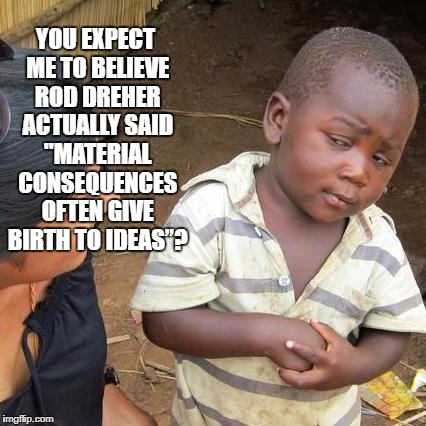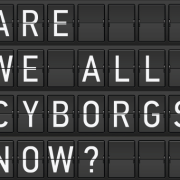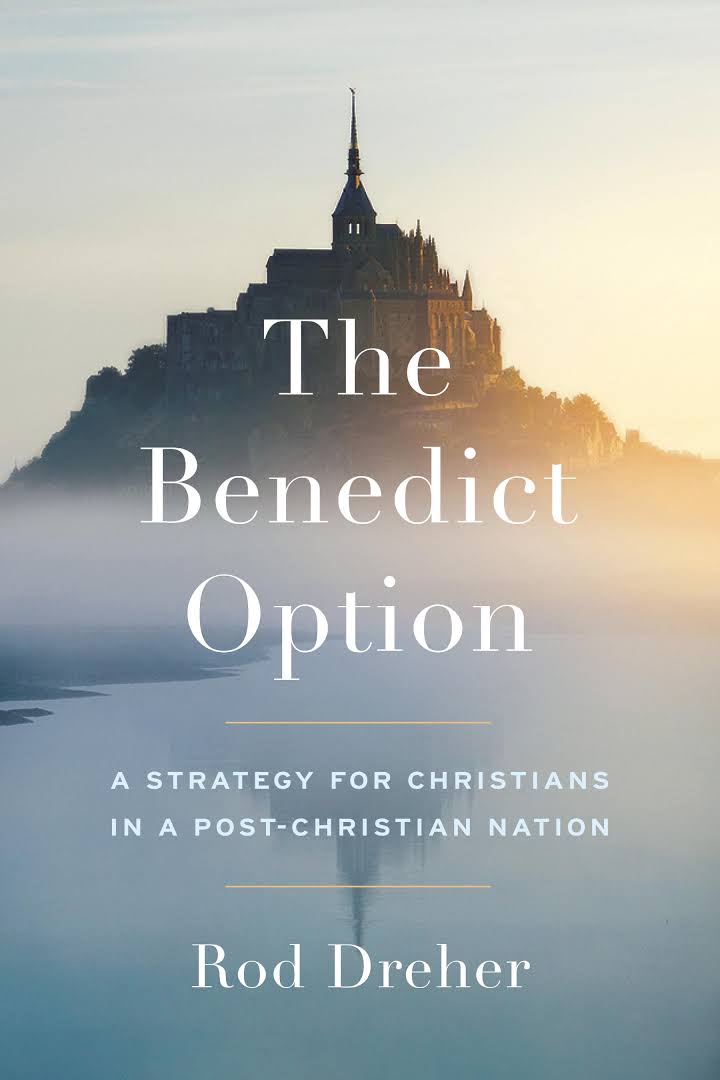
“In the fourteenth century, the loss of belief in the integral connection between God and Creation—or in philosophic terms, transcendent reality and material reality [he is talking about Nominalism vs. Realism here.]
The collapse of religious unity and religious authority in the Protestant Reformation of the sixteenth century
The eighteenth-century Enlightenment, which displaced the Christian religion with the cult of Reason, privatized religious life, and inaugurated the age of democracy
The Industrial Revolution (ca 1760-1840) and the growth of capitalism in the nineteenth and twentieth centuries
The Sexual Revolution (1960-present).”
As soon as I read this chapter, I knew that Dreher would face a chorus of critics condemning it as involving too intellectualist a reading of history, or claiming that he presented an oversimplified account of historical change overly weighted to the causative power of ideas. I knew this would happen, despite the fact that Dreher himself says that “material consequences often give birth to ideas” (remember that line) and that “History gives us no clean, straight causal lines binding events and giving them clear order.”
History that Goes Bump in the Night
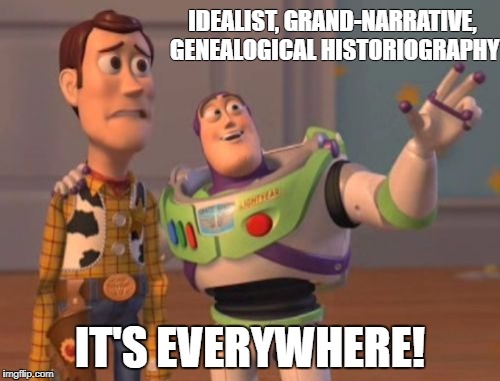
Sure enough, my prediction came true. Sam Rocha criticizes The Benedict Option for being “biased toward an intellectual understanding of historical causation. In truth, material consequences often give birth to ideas.” (Hmm, who was it that I quoted earlier saying that “material consequences often give birth to ideas”?)
Or take Noah Millman concerns. Referring to Alasdair MacIntyre historiography that set the stage for Dreher’s work, he refers to it as “Hegelian historicism.” Now this is kind of crazy, given that few thinkers worked as hard as MacIntyre to put philosophers back in their social and material contexts. Heck, just read After Virtue! (By “Hegeliam” Millman is referring to an ideas-drive-history approach, not the type of historical evolution associated with a thinker like Philip Schaff.)
Rod Dreher isn’t alone. Brad Gregory received similar criticism for his The Unintended Reformation, which Peter Escalante saw as involving “simplistic genealogical explanations.” In Escalante’s criticism, one of the problems is that Gregory “thinks that ideas drive history.” Jude Dougherty reviewed Gregory’s work with similar concerns in Volume 65, Issue 3 of The Review of Metaphysics. Last year Peter Leithart came under similar criticisms from Steven Wedgeworth, who was concerned that one of the “methodological fallacies” is the “’big story’” approach” (a fallacy that Leithart apparently shares in common with historians like Brad Gregory, MacIntyre and Weaver).
It’s almost like, in reaction to the questionable historiography of the Radical Orthodoxy movement, and the Nouvelle Théologie before that, or the incredibly sloppy historiography that dominates convert narratives in the anti-Protestant internet culture, not to mention the over-simplified accounts of Enlightenment unbelief or Victorian “doubt” that dominate Christian declension narratives, it has now become impossible to say anything about the causative power of ideas without a chorus of detractors ready to yell “Ideas-drive-history-approach—didn’t you know that history is not so simple?”
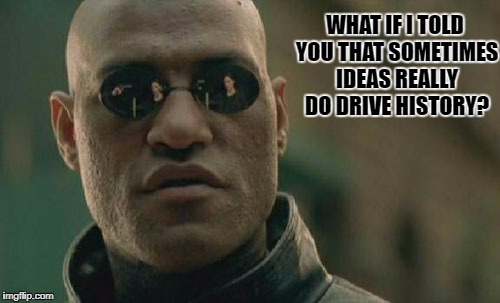
- When historians refer to the causative power of “ideas”, they usually mean “ideas” in a broad sense, akin to what Charles Taylor means by “the social imaginary.”
– - Ideas really do sometimes drive history.
– - Ideas and material factors are not rival agents of change but exist in a web of multiple reciprocities. Thus, when we say, “ideas sometimes drive history”, we do not mean “ideas” as something that is necessarily causally prior to material factors.
– - Those who dispute that ideas sometimes drive history run the risk of imposing a conceptual framework onto the facts of history and not letting the empirical data speak for itself.
What Type of “Ideas” Drive History?
There is always a temptation to look back on history and oversimplify the role of abstract ideas. For example, reading some accounts of the French Revolution and you could almost be forgiving for thinking that the women who marched on Versailles in 1789 had read The Social Contract. In some accounts of WWII, you could be forgiven for thinking that all the Nazi high command were well versed in Nietzsche. In my own Eastern Orthodox tradition, we frequently see this type of oversimplification when exaggerated East-West binaries are imposed on the historical record. So oversimplified historical accounts are a problem. However, it is possible to be mistaken about particulars without being mistaken about method. The real question we need to ask is not whether the ideas-drive-history framework has produced bad historiography (it clearly has), but whether there is something a priori suspect about the method itself. And should it even be considered a “method” as such, as opposed to a conclusion that may or may not be justified in certain instances?
These are questions I want to explore, but first it is necessary—as a kind of throat-clearing exercise—to define my terms. When we say, “ideas have historical consequences,” what do we mean by “ideas”? It is here that much of the confusion lies. Even in this most simplistic ideas-drive-history approach to historical change (for example, the type that might be associated, perhaps unfairly, with someone like Francis Schaefer or Nancy Pearcey, or in certain declension narratives popular in apologetic circles) ideas are rarely treated as abstract propositions disembodied from their material and social contexts. Rather, when these people say “ideas have consequences”, they almost always understand “ideas” in the broader sense that Tom Wright wrote about in his discussion of worldviews in The New Testament and the People of God, or that Charles Taylor has described by the “social imaginary,” or that James Davison Hunter articulated with the language of “pre-reflective frameworks,” or that James K.A. Smith (drawing on Heidegger) has written about as the “adaptive unconscious.” While each of these categories are not equivalent, and while each of these writers bring different perspectives to the discussion, what they share in common is the concern to move us beyond ideas which exist as merely disengaged concepts in a person’s head which can then be reduced to a set of propositions on paper. Instead, these writers have been attempting to draw our attention to unstated understandings that are part of the very background to how a people make sense of their world. Such “ideas” exist as implicit understandings that may or may not ever be explicitly articulated or cognitively recognized; but they are still “ideas” in so far as they form what Charles Taylor describes as, the largely unfocussed background which gives cohesiveness to group experience, “something much broader and deeper than the intellectual schemes people may entertain when they think about social reality in a disengaged mode.” Drawing on Wittgenstein, Taylor sees the social imaginary as a network of assumptions by which a people will posture themselves in relation to the world, a web of background understandings that forms the unconscious lens by which a people will interpret life and their experiences. While the social imaginary may exist in a symbiotic relationship with the explicit tenets of a person’s belief system, the former is not ultimately dependent on the latter, though dependence in the other direction is inescapable given that “all beliefs are held within a context or framework of the taken-for-granted, which usually remains tacit, and may even be as yet unacknowledged by the agent, because never formulated.” (A Secular Age, p. 13). The social imaginary is thus the type of lived condition which exists prior to explicit theological or philosophical reflection.
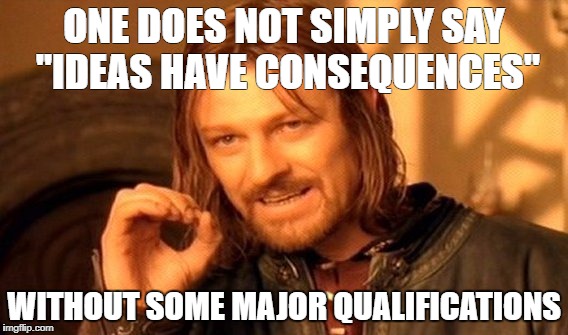
This dynamic is especially operative in religious cultures, where ecclesial traditions fuse with cultural mores to form what Martyn Percy has called “the implicit forces that shape ecclesial life.” Attention to these “forces” has the potential to give historians a more well-rounded and organic appreciation of religious change than can be attained by attending merely to the theological wordsmiths of a group. What Diarmaid MacCulloch noted when discussing beliefs in the afterlife in medieval Europe can find application in a variety of different contexts: “religion as practiced even by the self-consciously orthodox was not necessarily the same as religion that was officially recommended.” Accordingly, historians are now realizing that the most influential ideas animating a culture are those which are often invisible to an outside observer by virtue of being only tacitly articulated; assumptions which may percolate slightly beneath the surface so that they color and modulate everything else yet are rarely encountered in a distilled form. Such assumptions can exercise a formative influence on the unconscious schemas, probability structures and collective imagination that contribute to the social experience of a group, even if they remain elusive to direct analysis. Examples of this would be the way Mark Noll sees the idea of “republicanism” functioning in American religious thinking from the time of the French and Indian Wars to the time of Abraham Lincoln (see his book America’s God), or the way Nathan Hatch sees the idea of “democracy” influencing evangelical thinking during the age of the revivals (see his The Democratization of American Christianity), or the way James K.A. Smith sees “rationalism” tincturing much Protestant thinking about the spiritual life (see his series on cultural liturgies), or the way Philip Lee talked about “Gnosticism” in his Against the Protestant Gnostics. The aforementioned books are all apropos for our discussion, because they are all written by authors who have marshalled evidence to show that at particular times and periods, certain ideas really do drive history, but as a kind of “under-narrative” that may exist in tension to the tenets of explicit beliefs. This includes ideas that may not have even been named and categorized by people living at the time.
A case in point is Rod Dreher’s discussion of nominalism. Drawing on Charles Taylor, Dreher shows how the change from metaphysical realism to nominalism effected many areas of our civilization. Crucially, however, nominalism was most potent not as an abstract proposition but as a background operating system, like a lump of sugar dissolved throughout a cup of coffee. The cube of sugar sweetens everything even if you can no longer see it in solid form. Dreher shows that ideas have historical consequences, but that such ideas are most powerful when they are operational rather than abstract, when they are implicit rather than explicit, when they become part of the background for how people view the world, rather than merely limited to abstract propositions.
This puts me in a position to state the first two of the four central claims I want to make.
- When historians refer to the causative power of “ideas”, they mean “ideas” in a broad sense, akin to what Charles Taylor means by “the social imaginary.”
– - Ideas really do sometimes drive history.
I realize I have not yet given support for #1, but support for this claim will follow in the ensuing sections.
The Chicken-and-Egg Problem of Material vs. Ideal
Just as we need to understand “ideas” in the broad sense discussed above, we also have to understand causality in a more nuanced sense. When I say that ideas really do sometimes drive historical change, I am not positing ideas as a causative factor that precedes material factors, like a domino falling and then knocking over the next one. Unfortunately, material factors and ideas are often posited as rival agents of change, locking us in a chicken-and-egg situation of needing to determine in each case what has come first. But the reality is that ideal and material factors often form webs of reciprocal loops that elude linear sequencing. The same is true of other social factors that fall outside either the ideal or material, such as moral sensibility and aesthetic preferences. If, as I argued earlier, ideas should not be viewed in a way disengaged from the cultural institutions, myths, norms and imaginations in which such ideas are necessarily enmeshed, then we must not think of an idea coming first and then the material embodiment of that idea following on its heels; rather, we should think of both within a complex web of multiple reciprocities. Charles Taylor does a helpful job of highlighting this point:
“Certain moral self-understandings are embedded in certain practices, which can mean both that they are promoted by the spread of these practices, and that they shape the practices and help them get established.” (A Secular Age, p. 156)
“But in fact, what we see in human history is ranges of human practices which are both at once, that is, ‘material’ practices carried out by human beings in space and time, and very often coercively maintained, and at the same time, self-conceptions, modes of understanding. These are often quite inseparable…just because the self-understandings are the essential condition of the practice making sense that it does to the participants. Just because human practices are the kind of things which make sense, certain ‘ideas’ are internal to them; one cannot distinguish the two in order to ask the question, which causes which.” (A Secular Age, p. 212)
A concrete example may make my meaning more clear. Did the radicalization of Luther’s theology (an ideal factor) cause the peasant revolt (a material factor), or did the peasant revolt cause people to have an incentive to radicalize Luther’s theology? If what I said above is correct, then even posing the question like this may be invoking a false dilemma. The reality is that if we examine the evidence from the sixteenth-century, we see that the material and the ideal played off each other in cause and effect relationships that flowed both ways and in which neither had a temporal priority. But precisely because the cause and effects flow both ways, it is legitimate to talk about ideas driving history (influencing material factors) just as we can also talk about material factors driving ideas, and it can be appropriate simultaneously to take both approaches with the same historical phenomena when justified by the evidence.
This is not to say that ideas and material factors are indistinguishable (we really can distinguish between a radicalized and politicized doctrine of Sola Fide, on the one hand, and the fact of peasant starvation and oppression, on the other), only that they are not always divisible in the context of tracing social change. Thus, while we may not be able to divide ideas and material factors sufficiently to specify a chicken-and-egg causal relationship, we can still distinguish them, as when we speak of material events ‘carrying’ or ‘embodying’ certain implicit ideas and understandings. This leads us into my next proposition:
- Ideas and material factors are not rival agents of change but exist in a web of multiple reciprocities. Thus, when we say, “ideas sometimes drive history”, we do not mean “ideas” as something that is necessarily causally prior to material factors.
With this groundwork in place, let’s return briefly to The Benedict Option, before circling back to my first proposition (“ideas really do sometimes drive history”) to offer some support. One of the things that makes Chapter 2 so compelling and realistic is that Rod Dreher gives equal attention to both ideal and material factors as agents of change, avoiding the chicken-and-egg problem of pitting them against each other as rival causative factors. He discusses ideal factors such as fourteenth-century nominalism and fifteenth-century reformation theology, but he also discusses material factors like the Industrial Revolution and the Wars of Religion. Throughout it all, Dreher shows how complicated is the interconnected web of multiple reciprocities. Although his historical survey is necessarily oversimplified (how can you pack hundreds of years into a single chapter?) it is not reductionistic, unless we first assume that there can never be a case where ideas have historical consequences.
(As an aside, Rod tells me that when he first turned Chapter Two into the publisher, it was nearly 18,000 words. The editor told Rod that it needed to drastically be cut down to 7,500 words max. Rod told me that “Cutting that chapter down was the hardest task of writing the book.” Given what he was up against, let’s give Rod a little credit: few other writers would have been able to so skillfully pack this type of whirlwind historical tour into such a few amount of pages.)
Let the Data Speak!
It is problematic to overemphasize the role of “ideas” in shaping history, just as it is problematic to underemphasize it. An example of the latter would be if one disputed the legitimacy of ever using an ideas-have-consequences approach, even when the evidence justifies doing so. How then does a person know whether an ideas-have-consequences approach is justified when discussing a particular historical phenomenon or collection of phenomena? Simple: examine the evidence.
Let’s take a concrete example. Mark Noll may be correct in giving the idea of republicanism so much causative force in America’s God: From Jonathan Edwards to Abraham Lincoln, or maybe he isn’t justified; but there is no way to know independent of actually reviewing the evidence that has led him to this conclusion, and following the data wherever it leads. Thus, when used properly, an ideas-have-consequences approach is not so much a method as a conclusion. To dispute someone’s historical conclusions, you have to do more than merely scream “big story approach—methodological fallacy!”; rather, you have to get your hands dirty in all the details and show that in this particular instance such an approach is inconsistent with the data.
To use the “fallacy” card, as Steven Wedgeworth seemed to do in his discussion with Peter Leithart, can only really work if you first assume a universal negative premise about the a priori illegitimacy of such an approach regardless of the historical details in question. That is, you would need to already have some a priori reason for supposing that there could never be a case in the past history of the world justifying an ideas-have-consequences approach. (And let’s not forget that O statements on the Square of Opposition are incredibly difficult to prove.) The irony, however, is that those who play the “fallacy” card against overly intellectualist readings of history end up inadvertently doing what they criticize their opponents of doing: imposing a conceptual ideology onto the facts of history, only in this case the conceptual ideology is the framework that ideas never drive history. Again, in some cases ideas may drive history, and in other cases they may not, but we can never know without a thorough investigation of the evidence.

- Those who dispute that ideas sometimes drive history run the risk of imposing a conceptual framework onto the facts of history and not letting the empirical data speak for itself.
Ideas and Cultural Change: Responding to James Davison Hunter
One of the most formidable critiques of the ideas-have-consequences approach is found in James Davison Hunter’s 2010 book To Change the World. Hunter urged that “idealism mistakenly imputes a logic and rationality to culture where such linearity and reasonableness does not exist but rather contingency and accident.” He was critical of what he believed to be a modern manifestation of German idealism in the “worldview” approach adopted by evangelical apologists such as Chuck Colson, Nancy Pearcey and Os Guinness, or organizations like Campus Crusade, the Colson Center or Focus on the Family’s “The Truth Project.” In the framework of these apologists and organizations, Hunter alleged, cultural change always comes after changes in the hearts, minds and choices of the individuals who make up that culture, with the result that an enormous premium is placed on the centrality of a “Biblical worldview” to cultural change. Hunter contended that approach “is almost wholly mistaken” since it fails to reckon with the institutional nature of culture and “the way culture is embedded in structures of power.” Amassing an impressive array of empirical evidence, Hunter showed that cultural change primarily always happens from the top-down, being driven by the elites at the helm of the significant institutions and not by the thoughts and hearts of transformed individuals.
It is important to appreciate that Hunter himself allows for the formative role of ideas, concepts and norms provided one does not treat them as propositions disengaged from their cultural embeddedness. For example, one of Hunter’s “seven propositions on culture” is that “culture is a system of truth claims and moral obligations”. Such truth-claims, Hunter argues, exist as non-propositional understandings, being “embedded within narratives that often have overlapping themes and within various myths that often reinforce common ideals.” Well, that is exactly what I argued earlier in my discussion of ideas; more to the point, however, it is also what many of the Christian apologists Hunter unfairly criticizes have done a great job at actually pointing out. Their works are diffuse with references to the implicit narratives, assumption and “presuppositions” that animate American cultural institutions and which often do not exist in the form of distilled propositions. I should know because I worked for The Colson Center.
Laying the Ghost of Idealism to Rest
It may be helpful briefly to summarize the ground covered in this post, and relate it back to Chapter 2 of The Benedict Option.
I have argued that when historians refer to the causative power of “ideas”, their historiography is usually nuanced enough to take into account the role that implicit ideas can exercise on group experience even when those ideas are not stated in abstract form. This is certainly the case with Rod Dreher’s work. When ideas are understood in this more nuanced sense, it is entirely appropriate to say that ideas sometimes drive history, although the “driving” is not a one way street since ideas and material factors form feedback loops that work in both directions. To deny that ideas of historical consequences in this sense, would depend on first proving that there has never been a case in the history of the world where an ideas-have-consequences approach is justified by the data, for if it could be justified in some instances and not in others, then the only way to know which is which is to examine the historical record on a case by case basis. To assume a priori that Dreher is involved in a faulty method (i.e., “historicizing”, “big story approach”, “intellectualist historiography”, “grand narrative”, “idealism”, “historiographical storytelling”, “genealogical retelling of history”, etc) actually involves the imposition of a conceptual framework onto the historical record and represents a failure to let the evidence speak for itself. Moreover, these methodological objections short-circuit the type of critical engagement needed before we are in a position to evaluate whether the historiography of Dreher and others is legitimate.


